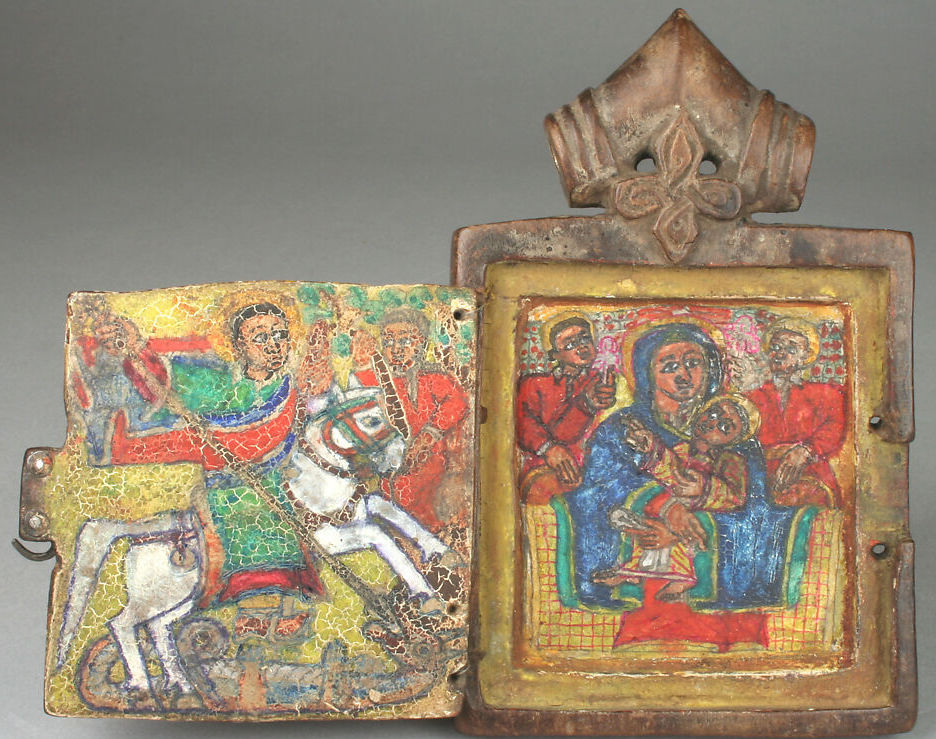Feast Day: April 23

When I was a little kid, the lovey that I snuggled up with at night was a stuffed green dragon. His name was Dragon (my childhood creativity knew no limits). It is with some trepidation then that I write about a man famous for being a dragon-slayer: St. George.
You might think that a story of a knight fighting a dragon might just be something for kids, but George gained a surprising amount of adult popularity. He serves as patron and protector of England. During World War II, Churchill named his personal plane “Ascalon,” the name of George’s legendary lance. George is also the traditional patron and protector of Ukraine as well as half a dozen other countries across Europe and Africa. Even Muslim countries honor him. What catapulted George into such popularity?

The Martyrdom of God’s Soldier
George lived and died in Roman times. We know that much, but not much else. When Pope Gelasius embarked in his fourth-century program of celebrating the Roman martyrs killed, he remembered George as one whose deeds remained known to God alone. Modern historians largely concur with his judgment.
Yet George was popular, even in Gelasius’ time. Many early references to him circulated and numerous shrines honored him, especially in the eastern Mediterranean where he likely lived. Something about him must have stood out.
Our earliest full account of his life comes from two or three centuries after his death. It tells us he was a Christian army officer who openly challenged his faith’s persecution. George first gave away all his wealth to the poor since he knew that his protest could have only one result: a horrible death. The Roman judicial system enthusiastically embraced torture and his story is quite gory. George faced the pain with complete trust in God. According to this text, the tortures followed a self-reinforcing cycle in which God would heal George or even resurrect his severed body, leading some bystanders to convert to the faith, but this would convince the king even more that George was an evil sorcerer needing more drastic measures. The king would then create a new torture and George would face it with sublime courage. So it went until finally God let him go to eternal rest.
Did something like that happen? Or did George simply state his faith with courage in public when others succumbed to the majority culture? We don’t know, but something about his bravery touched hearts.

The Knight and the Dragon
The dragon came later. George inherited the story from Theodore, another soldier-martyr. Theodore appeared in pictures slaying a dragon several centuries after Rome. George, being a similar saint, first appeared as a companion in those paintings and then George started fighting dragons on his own.
The most popular version of his later legend says that a dragon built a nest in the oasis that provided a small Libyan kingdom’s only fresh water. Initially the villagers lured the dragon away with sheep so they could rush in to get drinking water. Then the sheep were gone. They started using young people, chosen by random lot, as the bait. One day the lot fell on the king’s daughter. Despite the royal tears, the populace insisted the princess go to her fate.
Then God intervened. George, the brave Roman knight, happened to be riding past and saw the princess crying near the pond. He comforted her and told her to trust in him and in the Lord’s help. When the vile wyrm emerged to devour her, George charged the beast and speared it with his lance. Using the lady’s girdle as a leash, he dragged the wounded dragon into the city. There George made a bargain with the amazed townsfolk. If they converted to Christianity, George would dispatch the dragon forever. They agreed and he beheaded the dragon. Then George continued on his road towards his eventual martyrdom (after first marrying the princess in the more romantic versions of the story).

But Dragons Aren’t Real
Why is a saint so famous for something that clearly never happened? The answer lies in part with your high school English teacher: the meaningful stories we tell aren’t always literal. Medieval readers tended to be more sophisticated than us in that way, and more alive to layers of allegory and symbolism. The dragon is a common symbol of the Devil and Evil; the virgin girl is a symbol of innocence, goodness, and even the Church. The Bible’s Book of Revelation (ch. 12, 13, 20) uses that allegory. St. Perpetua, a Roman noblewoman who wrote a prison diary before her own martyrdom, described a vision from God in which a fierce dragon guarded the ladder to Heaven. Though terrified, she made the sign of the cross and called on God. That prayer forced the dragon to meekly lay down so she could step onto its head and from there onto the rungs of the ladder. The Roman martyrs like George truly faced a metaphorical Dragon that sought to devour the Church. Thanks to their courage and God’s grace, it failed.
Why did George become so popular? He was a warrior so warrior kings and medieval knights naturally gravitated towards his patronage. On a deeper level, however, St. George is popular because they yearned to be a hero fighting evil like him, even if just for one battle. I think that deep down we do too. The medieval kings and knights who promoted him fought (perhaps even as courageously as George), but their wars inflicted suffering on others all for the sake of pride, land, or money. Their battles were tawdry affairs, whose unworthy bloodshed seemed more likely to slowly drag them down to Hell than elevate them to Heaven. No wonder they longed for the example of a St. George or at least his intercession for mercy on them.
The Dragon Today
When we look at our own lives and our world, do we do better than medieval warriors? Perhaps the struggle for Christ seems distant from our lives. We don’t see the opportunities to stand for something good and be witnesses of hope, and so our dragons slither past us unchecked.
Perhaps we’ve convinced ourselves that some dragons aren’t really that bad. Pop culture so often celebrates things like war, the Mafia, or piracy, turning the evil into a lovable Dragon. Some such movies are genuinely artistic or entertaining, but do we mistake their fiction for reality? Do we have the courage to look at where the Devil is at work and say, “This is wrong”?
Perhaps we’ve gone to the opposite extreme and believe that the evils in our world are too big to have any hope of fighting. We’ve become cynical about heroes, expecting them to fail us. We focus on the human flaws in ourselves and others, and discount the power of God’s grace. Yet that grace empowers those who trust to do more than we ever thought possible.
With God, all things are possible. St. George, pray for us that we have the wisdom and courage to confront evil in our lives and to trust that God will see us through to His glory. And let us never forget that we have the greatest hero as our helper, the one who crushed even death: Jesus.
If you have a response, thoughts, or questions, please comment at the bottom of the page. Consider subscribing below to get weekly email notifications about new reflections and other news.



Glad to be reminded of how often I can feel overwhelmed by the evil in the world and forget to pray for courage and strength to continue the battle.
Thank you. Sending prayers your way.